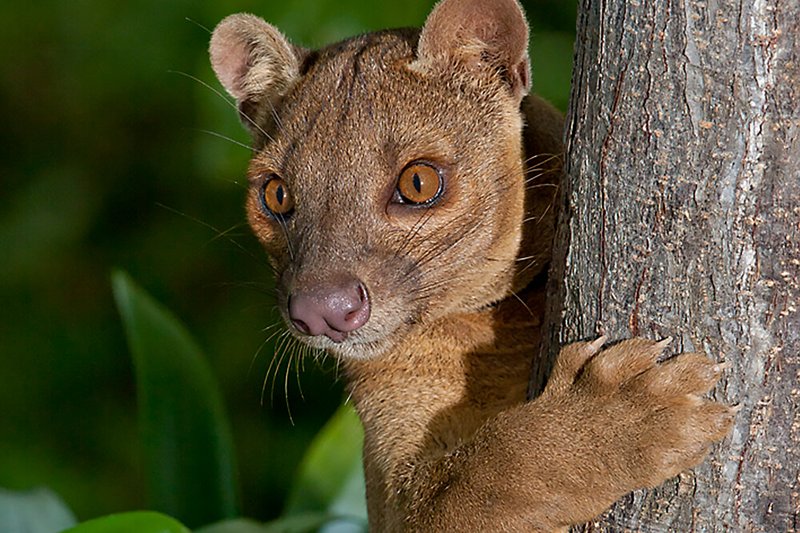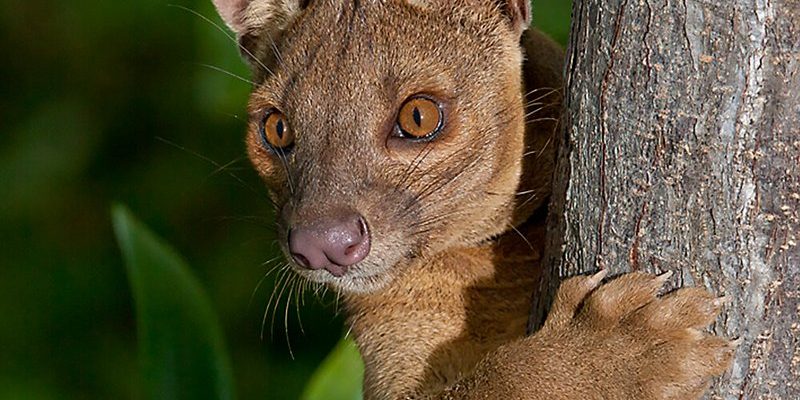
Picture this: you’re on a safari in Madagascar, and you spot a fossa lounging in the trees, its eyes glimmering in the sunlight. It’s a stunning sight, but you can’t help but wonder if this exotic animal poses any threat to you. Here’s the thing: while the fossa has sharp claws and a powerful bite, its danger to humans is more about misunderstanding than menace. Let’s dig deeper into this fascinating creature and find out just how dangerous a fossa really is.
What Is a Fossa?
The fossa (pronounced “foo-sah”) is a carnivorous mammal that’s part of the Eupleridae family. Think of it as Madagascar’s answer to a small puma. It can grow up to 6 feet long, including its long tail, which helps with balance when it’s climbing through the trees. With its slender body and cat-like face, the fossa looks like a cross between a cat and a mongoose.
You might be wondering about its habitat. Fossas thrive in Madagascar’s forests, where they are expert climbers and primarily prey on lemurs. They have a unique way of hunting, often stalking their prey silently before launching into action. While they have a fascinating role in the ecosystem, their isolated existence means they rarely encounter humans.
Fossa Behavior and Diet
Fossas are solitary animals, meaning they typically prefer to live alone rather than in groups. Their behavior is intriguing; they mark their territory using scent, often climbing trees to survey their surroundings. When it comes to diet, they’re carnivorous and have a varied menu.
- Lemurs
- Rodents
- Birds
- Reptiles
Their hunting skills are impressive. With keen eyesight and excellent agility, they can leap between branches and surprise their prey. However, their diet raises an interesting point—since they mainly eat small animals, they don’t rely on humans for food and thus have little reason to interact with us.
Are Fossas Aggressive Towards Humans?
Honestly, when it comes to fossa aggression, the answer is quite straightforward: they generally avoid humans. Fossas are not naturally aggressive creatures. They tend to be more skittish than confrontational. If they feel threatened, their instinct is to flee rather than fight.
That said, like any wild animal, a fossa could defend itself if cornered. This is true for many animals—we have to respect their space. You might find them snappish if they’re startled or protecting their young, but instances of fossa attacks on humans are extremely rare. It’s a classic case of “leave them alone, and they’ll leave you alone.”
Human Interactions with Fossas
As Madagascar continues to open up to tourism, human interactions with fossas may increase. This interaction can lead to misunderstandings about their behavior. Most tourists might be excited to see a fossa in the wild, but they should remember that these creatures are wild and unpredictable.
In areas where humans have encroached on their habitats, fossas might feel pressure to adapt. They could venture closer to villages in search of food, creating a situation where misunderstandings could arise. It’s always wise to observe wildlife from a distance, keeping both humans and animals safe.
Conservation Status and Threats
The fossa isn’t just a curious creature; it’s also a species at risk. Due to habitat destruction, primarily from deforestation, their numbers are declining. This loss of habitat is one of the biggest threats to their survival. Without trees to climb and hunt, fossas are in danger of losing their homes.
Conservation efforts are crucial for ensuring the fossa doesn’t become endangered. Protecting Madagascar’s forests not only helps fossas but also preserves many other unique species native to the island. Supporting sustainable tourism and conservation initiatives can make a difference.
So, can the fossa be dangerous to humans? The short answer is no. While their sharp teeth and claws may seem intimidating, fossas are not typically a threat. They’re more likely to shy away from humans than engage with them.
Understanding these fascinating creatures helps us appreciate their role in the ecosystem—and it emphasizes the importance of protecting their habitats. Just like any wild animal, respect is key. If we admire fossas from a distance and support conservation efforts, we can ensure that these remarkable animals thrive in their natural habitat, safe from harm—and keep humans safe from unnecessary fear as well.

